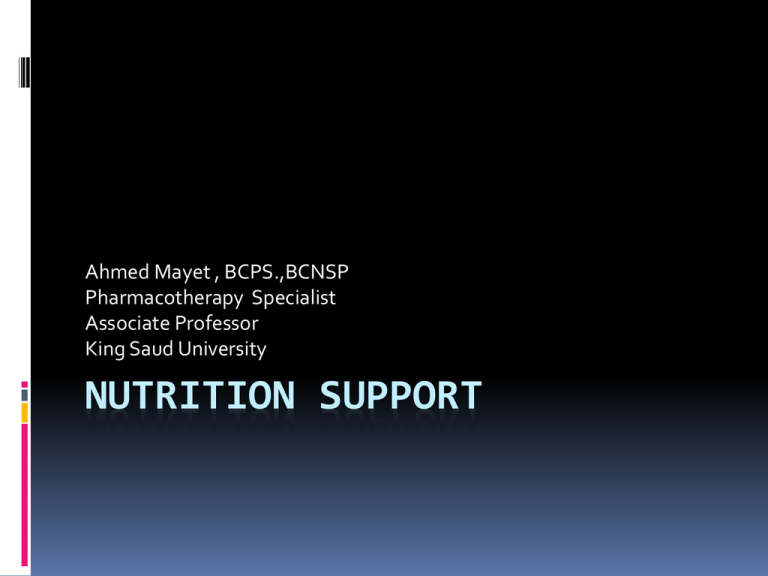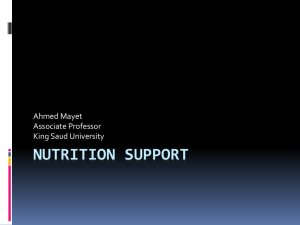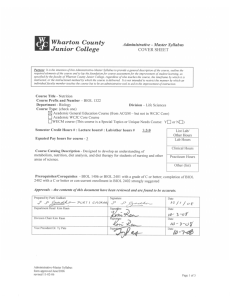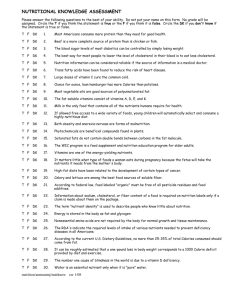01 Nutrition Support..
advertisement

Ahmed Mayet , BCPS.,BCNSP Pharmacotherapy Specialist Associate Professor King Saud University NUTRITION SUPPORT Nutrition Nutrition—provides with all basic nutrients and energy required for growth, repair and maintenance of the body function. Nutrition comes from carbohydrate, fat, protein, electrolytes, minerals, and vitamins. Malnutrition Malnutrition Come from extended inadequate intake of nutrient or Severe illness burden on the body composition and function—affect all systems of the body Metabolic Rate Resting metabolism (% of normal) Major burn Sepsis Trauma Partial starvation Total starvation 180 160 140 120 100 Normal range 80 60 0 10 20 30 Days 40 50 Long CL, et al. JPEN 1979;3:452-6 Protein Catabolism Major burn Trauma Sepsis Partial starvation Total starvation Nitrogen excretion (g/day) 30 25 20 15 10 Normal range 5 0 0 10 20 30 40 Days Long CL. Contemp Surg 1980;16:29-42 Types of malnutrition Kwashiorkor: (kwa-shior-kor) is protein malnutrition Marasmus: (ma-ras-mus) is protein-calorie malnutrition Kwashiorkor Protein malnutrition - caused by inadequate protein intake in the presence of fair to good calories intake in combination with the stress response Common causes - chronic kidney disease, liver cirrhosis, trauma , burns, hemorrhage, and critical illness Clinical Manifestations Marked hypoalbuminemia Edema and ascites Muscle atrophy Delayed wound healing Impaired immune function Marasmus The patient with severe protein-calorie malnutrition characterized by calories deficiency Common severe burns, injuries, systemic infections, cancer etc or conditions where patient does not eat like anorexia nervosa and starvation Clinical Manifestations Weight loss Depletion skeletal muscle and adipose (fat) stores Bradycardia Hypothermia Risk factors for malnutrition Medical causes Psychological Social causes Medical causes (Risk factors for malnutrition) Recent surgery or trauma Sepsis Chronic illness Gastrointestinal disorders Anorexia, other eating disorders Dysphagia Recurrent nausea, vomiting, or diarrhea Inflammatory bowel disease Psychosocial and social causes Alcoholism, drug addiction Poverty, isolation Disability Anorexia nervosa Consequences of Malnutrition Malnutrition places patients at a greatly increased risk for morbidity and mortality Longer recovery period from illnesses Impaired host defenses (Infections) International, multicentre study to implement nutritional risk screening and evaluate clinical outcome “Not at risk” = good nutrition status “At risk” = poor nutrition status Results: Of the 5051 study patients, 32.6% were defined as ‘atrisk’ At-risk’ patients had more complications, higher mortality and longer lengths of stay than ‘not at-risk’ patients. Sorensen J et al ClinicalNutrition(2008)27,340 349 International,multicentre study to implement nutritional risk screening and evaluate clinical outcome ClinicalNutrition(2008)27,340e349 International,multicentre study to implement nutritional risk screening and evaluate clinical outcome ClinicalNutrition(2008)27,340e349 Laboratory and other tests Weight BMI Fat storage Somatic and visceral protein Standard monogram for Height and Weight in adult-male Height Small Frame Medium Frame Large Frame 4'10" 102-111 109-121 118-131 4'11" 103-113 111-123 120-134 5'0" 104-115 113-126 122-137 5'1" 106-118 115-129 125-140 5'2" 108-121 118-132 128-143 5'3" 111-124 121-135 131-147 5'4" 114-127 124-138 134-151 5'5" 117-130 127-141 137-155 5'6" 120-133 130-144 140-159 5'7" 123-136 133-147 143-163 5'8" 126-139 136-150 146-167 5'9" 129-142 139-153 149-170 5'10" 132-145 142-156 152-173 5'11" 135-148 145-159 155-176 6'0" 138-151 148-162 158-179 A pt with 110 lbs and Ht 5’ 9” (Percent weight loss) Small frame 129 lbs – 110 lbs = 19 lbs 19/129 x 100 = 15% Medium frame 139 lbs – 110 lbs = 29 lbs 29/139 x 100 = 20% Severe weight lost Time Significant Weight Loss (%) Severe Weight Loss (%) 1 week 1-2 >2 1 month 5 >5 3 months 7.5 >7.5 6 months 10 >10 Laboratory and other tests Weight BMI Fat storage Somatic and visceral protein Average Body Mass Index (BMI) for Adult Classification BMI (kg/m2) Underweight Normal Overweight Obesity <18.5 18.5-24.9 25.0-29.9 30.0-34.9 Moderate obesity Extreme obesity 35.0-39.9 >40.0 Obesity Class I II III Laboratory and other tests Weight BMI Fat storage Somatic and visceral protein Fat Assessment of body fat Triceps skin fold thickness (TSF) Compare the patient TSF to standard monogram Laboratory and other tests Weight BMI Fat storage Somatic and visceral protein Protein (Somatic Protein) Assessment of the fat-free muscle mass (Somatic Protein) Mid-upper-arm circumference (MAC) Compare the patient MAC to standard monogram Vitamins deficiency Vitamin Bs (B1,B2, B6, B12, ) Vitamin C Vitamin A Vitamin D Vitamin K - Clinical Sign or Symptom Nutrient General Wasted, thin Calorie - Loss of appetite Protein-calorie Skin Eczematous scaling Zinc - *Pallor Folate, iron, vitamin B12, copper Follicular hyperkeratosis Vitamin A Flaking dermatitis Protein-calorie, niacin, riboflavin, zinc *Bruising Vitamin C, vitamin K - Pigmentation changes Protein-calorie, niacin - Scrotal dermatosis Riboflavin Neck Goiter Iodine - Parotid enlargement Protein Thorax Thoracic rosary Vitamin D Abdomen Diarrhea Niacin, folate, vitamin B12 - Distention Protein-calorie - Hepatomegaly Protein-calorie Extremities *Edema Protein, thiamine - Bone tenderness Vitamin D - Muscle wasting Protein, vitamin D, selenium Nails - *Hyporeflexia Ataxia *Spooning Transverse Thiamine Vitamin B12 Iron Protein ESTIMATING ENERGY/CALORIE Basic energy expenditure (BEE) Basal metabolic rate (BMR), also called the basic energy expenditure (BEE) support the body's most basic functions when at rest in a neutral, or non-stressful, environment. It accounts for the largest portion of total daily energy requirements ( up to 70%) Harris–Benedict Equations Energy calculation Male BEE = 66 + (13.7 x actual wt in kg) + (5x ht in cm) – (6.8 x age in y) Female BEE = 655 + (9.6 x actual wt in kg) + (1.7 x ht in cm) – (4.7 x age in y) Total Energy Expenditure TEE (kcal/day) = BEE x stress/activity factor A correlation factor that estimates the extent of hyper-metabolism 1.15 for bedridden patients 1.10 for patients on ventilator support 1.25 for normal patients The stress factors are: 1.3 for low stress 1.5 for moderate stress 2.0 for severe stress 1.9-2.1 for burn Calculation Our patient Wt = 50 kg Age = 45 yrs Height = 5 feet 9 inches (175 cm) BEE = 66 + (13.7 x actual wt in kg) + (5x ht in cm) – (6.8 x age in y) =66 + (13.7 x 50 kg) + (5 x 175 cm) – (6.8 x 45) =66 + ( 685) + (875) – (306) = 1320 kcal TEE = 1320 x 1.25 (normal activity) = 1650 kcal CALORIE SOURCES Calories 60 to 80% of the caloric requirement should be provided as glucose The remainder 20% to 40% as fat 15% can be from protein To include protein calories in the provision of energy is controversial specially in parentral nutrition FLUID REQUIREMENTS Fluid The average adult requires approximately 35- 45 ml/kg/d NRC* recommends 1 to 2 ml of water for each kcal of energy expenditure *NRC= National research council Fluid 1st 10 kilogram 2nd 10 kilogram Rest of the weight 100 cc/kg 50 cc/kg 20 to 30 cc/kg Example: if pt is 50 kg 1st 10 kg x 100cc = 1000 cc 2nd 10 kg x 50cc = 500cc Rest 30 kg x 30cc = 900cc total = 2400 cc PROTEIN NEEDS Protein The average adult requires about 1 to 1.2 gm/kg 0r average of 70-80 grams of protein per day Protein Stress or activity level Initial protein requirement (g/kg/day) Baseline 1.4 g/kg/day Mild stress 1.8 g/kg/day Moderate stress 2.0 g/kg/day Severe stress 2.2 g/kg/day ROUTES OF NUTRITION SUPPORT The nutritional needs of patients are met through either parenteral or enteral delivery route ENTERAL NUTRITION Enteral The gastrointestinal tract is always the preferred route of support (Physiologic) EN is safer, more cost effective, and more physiologic that PN “If the gut works, use it” Potential benefits of EN over PN Nutrients are metabolized and utilized more effectively via the enteral than parenteral route Safety Catheter sepsis Pneumothorax Catheter embolism Arterial laceration Contraindications Gastrointestinal obstruction Severe acute pancreatitis High-output proximal fistulas Intractable nausea and vomiting or osmotic diarrhea Enteral nutrition (EN) Long-term nutrition: Gastrostomy Jejunostomy Short-term nutrition: Nasogastric feeding Nasoduodenal feeding Nasojejunal feeding Intact food Predigested food TF = tube feeding TOTAL PARENTRAL NUTRITION PN Goal Provide patients with adequate calories and protein to prevent malnutrition and associated complication PN therapy must provide: Protein in the form of amino acids Carbohydrates in the form of glucose Fat as a lipid emulsion Electrolytes, vitamin, trace elements, minerals PATIENT SELECTION General Indications Requiring NPO > 5 - 7 days Severe gut dysfunction or inability to tolerate enteral feedings. Can not eat, will not eat, should not eat Special Indications : After major surgery Pt with bowel obstruction Pt with enterocutaneous fistulas (high and low) Massive bowel resection Malnourished patients undergo chemotherapy NPO for more than 5 days for any reasons Necrotizing pancreatitis Cont: Burns, sepsis, trauma, long bone fractures Premature new born Renal, hepatic, respiratory, cardiac failure (rarely) 2.5gm/kg/d ADMINISTRATION Administration Central line Peripheral line Parenteral Nutrition Central Nutrition Subclavian line Long period High osmolality > 2000 mOsm/L Full Calories Minimum volume More Infections More complications Peripheral Nutrition Peripheral line Short period < 14days Low osmolality < 1000 mOsm/L Min. Calories Large volume Thrombophlebitis Less complications COMPLICATIONS OF TPN Complications Associated with PN Mechanical complication Septic complication Metabolic complication Mechanical Complication Improper placement of catheter may cause pneumothorax, vascular injury with hemothorax, and cardiac arrhythmia Venous thrombosis after central venous access Catheter sepsis Pneumothorax Catheter embolism Arterial laceration Infectious Complications The mortality rate from catheter sepsis as high as 15% Aseptic technique - inserting the venous catheter Aseptic technique - compounding the solution Catheter care at the site – regular dressing Metabolic Complications Early complication -early in the process of feeding and may be anticipated Late complication - caused by not supplying an adequate amount of required nutrients or cause adverse effect by solution composition THANK YOU






